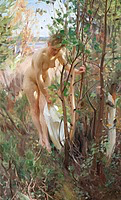Anders Zorn
"En Eva"
Signed Zorn and dated 1902. Canvas 127 x 78.5 cm.
Saleroom notice
Wrongly stated provenance E. Starwing collection.
Provenance
Originally acquired directly from the artist by the industrialist Arend N. Versteegh (-1931), Härnösand, Sweden.
Thence by inheritance within the family.
Nordén Auktioner, Stockholm, 19 November 1998, Sale nr 29, lot 203.
Private collection, Sweden.
Exhibitions
Kunst-Verein Bremen (year unknown).
Budapest, Hungary, 1903, cat nr 90 (under the title "Eva Nach dem Bade").
Kunst-Salon Ernst Arnold, Dresden, Germany, "Sonderausstellung (72)", 1904.
"Gammalt och Nytt", Uppsala, Sweden, 1906.
The Baltic Exhibition, Malmö, Sweden, 15 May - 4 October 1914, cat nr 125.
Liljevalchs Konsthall, Stockholm, Sweden, "Invigningsutställning. Larsson-Liljefors-Zorn", March - April 1916, cat nr 121.
Liljevalchs Konsthall, Stockholm, Sweden, "Anders Zorn. Minnesutställning", 1 March - 6 April 1924, cat nr 45.
Literature
Ernst Malmberg, "Larsson-Liljefors-Zorn", 1919, illustrated in interior photograph from the exhibition at Liljevalchs 1916, page 117, mentioned page108.
Tor Hedberg, "Anders Zorn 1860-1920", SAK, 1923, mentioned page 58-60 and illustrated, "Bild 42" (under the title "Naken kvinna i barrskog"), page 62 (with erroneus information regarding the ownership of the painting).
Gerda Boëthius, "ZORN. Tecknaren. Målaren. Etsaren. Skulptören", 1949, mentioned page 422-423, illustrated full page, Fig. 230 (as executed 1901-02) and catalogued under year 1901, page 550.
Gerda Boëthius, "Zorn. Människan och konstnären", 1960, mentioned page 178.
Anders Zorn, "Självbiografiska anteckningar" (edited by Birgitta Sandström), 2004, illustrated full page in colour, page 260.
More information
.
Designer
Anders Zorn, born in Mora in 1860, showed artistic talent from a young age. In 1875, he traveled to Stockholm and became a student at the then Slöjdskolan (now Tekniska högskolan) in Stockholm, and shortly after, he joined the Royal Academy of Fine Arts. Initially, Zorn had aspirations of becoming a sculptor, but soon watercolor painting took over, becoming his primary medium until 1887. At the student exhibition in 1880, Zorn had his breakthrough with the watercolor painting "I sorg." The following year, he gained international acclaim as a portrait painter. His watercolor painting reached its pinnacle during this period, and his most famous work from this time is "Vårt dagliga bröd” from 1886. Shortly thereafter, Zorn transitioned to oil painting, which was met with immediate success. Zorn's reputation mainly rested on his portrait art, and he portrayed many notable figures, including presidents. For instance, he created an etching of Theodore Roosevelt. His etchings significantly contributed to his success. In the late 1880s, Zorn began working in the genre that would increasingly become his trademark: nude figures in outdoor settings. He had long been fascinated by the movement of water and the reflections of light on its surface. Now, he added the complexity of placing a model near or in the water, aiming to depict a synthesis between nature and humanity. In 1896, Zorn and his wife moved back to Sweden and settled in Zorngården in Mora. This move sparked a renewed interest in his homeland, which would be reflected in his future paintings. Among the artist's scenes from the Mora region, portraying its local customs and ancient traditions, "Midsommardansen" holds the highest value according to Zorn himself. Today, the painting can be found at the National Museum.
Read more



















































